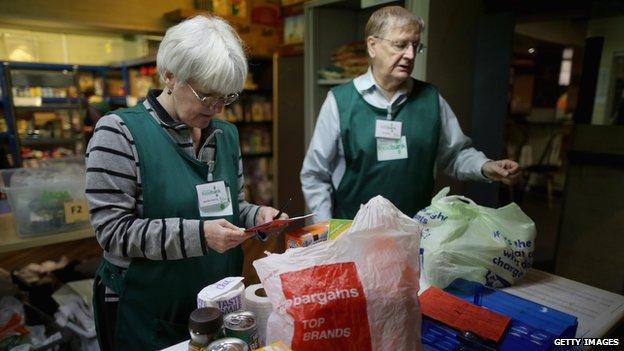Reality Check: Are there a million food bank users?
- Published

The rise in food bank use has been quoted throughout the election campaign. Jeremy Paxman's first question to David Cameron was about them.
According to figures released today, the use of food banks has passed the one million mark. But is this the true picture?
Food banks provide free food to people in acute need. Normally, those needing help must be referred by a doctor, social worker, or Jobcentre staff, who give them a voucher to exchange for food.
The Trussell Trust, which manages the UK's largest network of food banks, says that 1,084,604 people received three days' food in 2014/15 - a rise of 19% from the previous year.
However, this isn't the same as one million individuals using food banks - some people will turn to a food bank on several occasions. In fact, the Trussell Trust says that on average people who used its food banks needed two food bank vouchers a year. If we use this figure for an estimate, then the number of unique users drops to around 500,000.
The Trussell Trust is our main source of data on food bank use. Its statistics are collected via an online system where food banks enter the data from each voucher. A voucher feeding a family of five would show up as five people receiving help. The government does not collect its own data because it says that food banks are community-run and it would place an unnecessary administrative burden on volunteers.
However, there have been various official reports on UK food banks in an attempt to understand what is behind the surge in their use. On each voucher the person making the referral ticks a box explaining the reason why someone is in need of help.
The Trussell Trust said that problems with benefits was the main reason people needed vouchers and there had also been an increase in those on low incomes seeking help. This echoes the conclusions of a cross-party group of MPs, who in a report published at the end of last year concluded that the high cost of living, alongside delays to benefit payments, was to blame for the rise in food bank use.
It is worth noting that not all food banks use a voucher system, while drop-in centres and shelters offer help on a more informal basis. All told, it's estimated there might be 1,500 different organisations providing emergency food assistance across the UK, although there is no comprehensive data on their use.
Trussell Trust statistics show that use of their food banks has grown each year since 2003/04 - the earliest year for which we have data. However, the number of food banks also increased during this period: the Trust operated two foodbanks in 2003/04, compared with 445 in 2014/15. This means more people now have a local food bank, while there's greater public awareness of the help on offer.
The government also points out that since 2011 Jobcentre staff have been able to refer people to food banks, which wasn't allowed before. Despite these considerations, a report commissioned by the government said that demand for food banks was driving supply - not the other way round.
Nevertheless, the UK is not alone in seeing an increase in food bank use. The problem is also in evidence elsewhere in Europe and the US. As the UN has noted, the problem of food poverty is a reflection of greater societal inequality, not just fluctuations in a local economy.

Election 2015 - Reality Check

What's the truth behind the politicians' claims on the campaign trail? Our experts investigate the facts, and wider stories, behind the soundbites.
Read latest updates or follow us on Twitter @BBCRealityCheck, external
